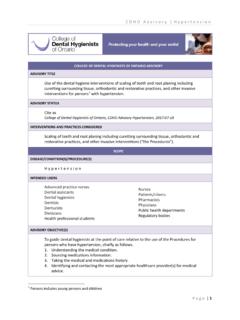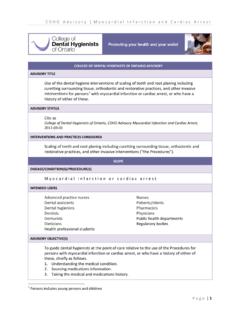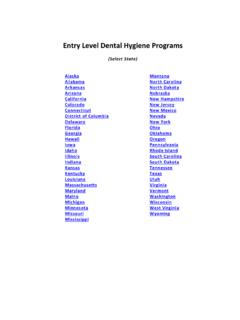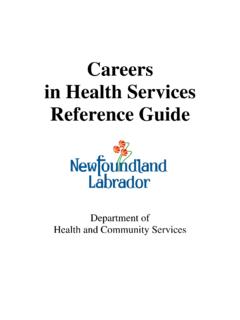Transcription of Dental HYgiene facts Pit and Fissure Sealants - …
1 D e n t a l hy g i e n e f a c t s Pit and Fissure Sealants For cavity prevention A sealant is a strong, plastic, clear or tooth-coloured coating that a Dental hygienist applies to the chewing surfaces of the back teeth where pit and fissures form. A sealant acts as a barrier, protecting the enamel from bacterial plaque in these cavity-prone areas. THE IMPACT ON ORAL HEALTH. Fissures are the grooves on the chewing surface of the back teeth caused by normal tooth development. Pits form where two fissures cross. Thorough brushing and flossing help remove food particles and plaque from smooth surfaces of teeth. Pits and fissures, however, are extremely difficult places to clean.
2 Toothbrush bristles cannot reach all the way into the depressions and grooves to remove food and plaque. A properly placed sealant will last for about as long as a typical amalgam filling. Even if a sealant is The enamel layer can also be particularly thin in pits damaged or lost, it is easily repaired or replaced. and fissures, causing decay to progress easier, faster and deeper into the grooves. Sealants protect these Sealants are safe for use on everyone's teeth, from vulnerable areas by sealing out plaque and food. young children to adults. In addition to being an effective preventive measure, CANDIDATES FOR Sealants Sealants cost less than having a cavity filled.
3 The likelihood of developing pit and Fissure decay begins early in life, so children and teenagers are TREATMENT AND CARE. obvious candidates, but adults can benefit from Dental hygienists will examine the teeth to determine if Sealants as well. a pit and Fissure sealant would be beneficial. They assess the person's risk for pit and Fissure decay. Risk The most commonly treated teeth are permanent can also vary for the same person over time, because molars and premolars, the teeth directly in front of the changes in personal habits, health status and molars. In some cases, primary molars with deep pits medication use are known to increase risk for decay.
4 And fissures can also be sealed. Usually Sealants are Lack of access to fluorides and fluoridated water, a applied to a child's teeth as soon as they are fully history of previous decay and chronic dry mouth are erupted, before the decay process can begin. additional factors to take into account when considering Sealants . ADVANTAGES. Properly applied, Sealants are very effective in The application process preventing decay in pits and fissures. Even early Correct application is important. decay appears to stop when covered with a sealant, Teeth must be kept dry throughout various stages of because decay-causing bacteria are unable to survive the procedure.
5 If not, the sealant material may not when cut off from their food supply. adhere properly. The application of a sealant is quick, easy and After the teeth are cleaned, treated and dried, the painless. No drilling or freezing are required. sealant is painted into the grooves. cont'd next page Dental hygienists : Your Partners in Oral Health The sealant is then hardened with a curing light to HYgiene with daily toothbrushing and flossing. form a protective coating. A diet following Canada's Food Guide, which is low Excess sealant material can be easily buffed to in sugar and high in nutrition, is always ensure a proper bite. recommended. Occasionally a pit and Fissure sealant will pop out.
6 Maintenance and home care During regular visits, Dental hygienists will check Once the sealant is bonded in place, clients Sealants and replace any that are worn or missing. can resume their normal activities. Dental exams continue to be important, No special home care is required to since decay can still occur under and around maintain Sealants . the sealant. Those who have had their teeth sealed should continue practising good oral As professional health-care providers, Dental hygienists are primarily concerned with promoting good oral health. Dental HYgiene is among the largest of the regulated healthcare professions in the province. In Ontario all Dental hygienists are registered with the College of Dental hygienists of Ontario, which regulates the profession to ensure the public receives safe and ongoing comprehensive oral care.
7 Dental hygienists : Your Partners in Oral Health



